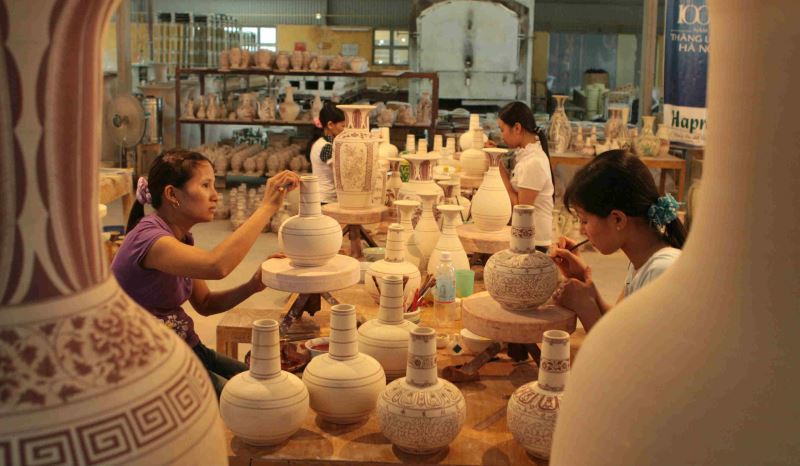Chu Dau means boat dock. In the 15th century, Chu Dau was a commune of Nam Sach district, Hai Duong region, on the left bank of the Thai Binh river, making for convenient trade between Chu Dau and Thang Long, the former name of Ha Noi.
The local pottery flourished from the 14th to 17th century and later waned in popularity. A revival of the pottery village bagan in 1980. In that year, Makoto Anabuki, the first secretary of the Japanese Embassy in Viet Nam sent a letter to Ngo Duy Dong, Secretary of the Party Committee of Hai Hung Province (now Hai Duong and Hung Yen provinces).
Makoto Anabuki wrote that he examined in a museum in Turkey a 54cm-high vase imprinted with indigo patterns. On the vase were 13 Chinese characters meaning the 8th year in the reign of Thai Hoa which was 1450, the potter’s family name: Bui, and the district of origin: Nam Sach.
Nguyen Huu Hiep, Deputy Director of the Chu Dau Pottery Joint Stock Company, described this letter as the spark that revived the traditional craft village. In 1983, a search for traces of the ancient pottery began with the archaeological excavation of Chu Dau.

By 2003, Vietnamese archaeologists had salvaged 400,000 items from a sunken ship near Cu Lao Cham Island in central Quang Nam Province, drawing the world’s attention to the pottery. Chu Dau had been recognized as one of the world’s most beautiful pottery styles from the 14th to the 17th century.
In 2001, the Ha Noi Trade Corporation (Hapro) began research to improve the pottery glaze, production techniques, and designs, revitalizing the traditional pottery village of Chu Dau.
Nguyen Huu Hiep, Deputy Director of the Chu Dau Pottery Joint Stock Company, said “Studies found that the glaze of Chu Dau pottery was made from natural occurring materials. We use the ashes of burnt rice husks to make the glaze. The ink is made of ochre taken from the mountains. Chu Dau pottery does not contain any toxic chemicals and has the same glaze used by our ancestors”.

Chu Dau pottery has been called the pottery of religion because its inctricate patterns include symbols of Buddhism and Confucianism. Other of its delicate patterns and designs represent the beauty of the Vietnamese culture and the civilization of the Red River delta.


Nguyen Huy Kien, Deputy Director in Charge of Production of the Chu Dau Pottery Joint Stock Company said “Today, the production of Chu Dau pottery uses both modern and traditional techniques. The designs are basically the same, but we can add some more modern patterns if the customer asks. What is special about Chu Dau pottery is the glaze, which is made from the ashes of burned rice husks. That’s the way our ancestors did it. The enamelling and firing steps take place after imprinting the patterns. All the materials are refined and clean”.
Chu Dau pottery products are special because they are hand-made from start to finish.

Tran Thi Ngan, one of first potters to be trained to revive the craft, said “Every craft village is unique. Our pottery village focuses on designs that are associated with agriculture and the daily life of our ancestors. It’s not easy to learn the craft, especially the painting techniques. It takes a whole year to become a skilled potter and this job requires passion”.
In addition to reviving the ancient craft, the Chu Dau Pottery Joint Stock Company has begun to develop craft village tourism. A craft center covering an area of several thousands square meters has been built. The company has also set up a garden of pottery and calligraphy and a temple for worshiping the ancestors.
“Our overall goal is to make Chu Dau one of the world’s most prestigious pottery sources. The products should be clean, safe and aesthetic. We will also create a craft village opened to domestic and foreign tourists,” Hiep noted.
Chu Dau pottery items can be found at 46 museums in 32 countries around the world and are sold in 20 countries.
According to VietKings (Kyluc.vn)









